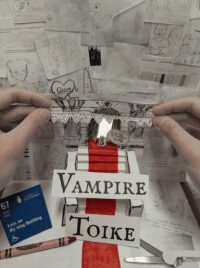
During recent tests to ensure the dye station had met official safety standards for F!rosh week, a lab analysis was conducted by chemical engineering student, Violet Dai, which revealed evidence of a particular strain of the Ebola virus in the dye. This raised many concerns among organizers. As put by one dye station manager, “Ahhhhh well, what’re you gonna do. The kids’re all fine ya know? I didn’t hear’f a single incident so it’s definitely a success.” When I tried to tell him of the two frosh currently in critical condition at Mount Sinai, he stuck his fingers into his ears, closed his eyes and loudly yelled “LA LA LA LA LA, I CAN’T HEAR YOU!!!”
Although the dye station manager seemed assured that everything was perfectly under control, some concern was raised leading to a meeting between the orientation chair and EngSoc, to discuss the fate of the leftover dye. Many legitimate concerns were raised by EngSoc representatives but were immediately rebutted with just as strong counter-arguments like “Dye is expensive you know? You can’t just throw it away!” and “It’s just one strain!” and “BUT PURPLE IS PRETTY!” After much back and forth banter, a consensus was reached by a marginal vote that the dye was in fact not to be discarded as the virus would probably die if kept sealed in the dye container long enough anyway.
As the managers put it, “Most of the cases are in Western Africa anyway, so statistically the chances of the virus working in Canada are tiny. Furthermore, I read somewhere on the internet that the virus is actually just a scare tactic created by the Illuminati and we all know that the internet is completely 100% reliable all the time.” He claims that a normal dip in the tub will be completely safe. “Just don’t drink it ‘cause the alcohol will probably kill you.”
The orientation chair agreed it was a win-win situation, as not having to change the dye saved resources while the chance of infection of a frosh was practically almost non-existent, more or less. When questioned about the two students currently in critical condition, he explained proudly that there were “1200 incoming students, which is like sooooo many students, so 1 or 2 accidents were less than one percent, which is pretty good and would probably more likely be a rounding error anyway.”



